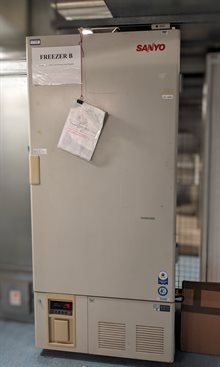Lab Equipment guidance
Labs account for a significant portion of the university's total carbon emissions, as much as 50%, yet occupy a minority of space. Two key priorities identified within the university's, Carbon Management Plan are to reduce the demand for energy, and to increase the efficiency of systems and equipment. Labs have an important role to play in both.
General lab equipment
Why is equipment left on?
Labs often have equipment left on all the time. The question we all need to ask is why? Some equipment needs to be on for experiments, or it is detrimental to it to turn it off. But equipment is often left on for no good reason. Amid a climate and energy crisis, this is not acceptable.
If equipment can be turned off at certain times, UoN can supply timer switches. These switches allow equipment to be turned off at a desired time that will not interfere with the day-to-day operation.
To obtain a timer, email sustainability@nottingham.ac.uk. Please note that your lab will have to have a LEAF accreditation, to receive a timer switch.
Why is equipment left on standby?
Equipment left on standby mode still use energy. An 800w microwave uses 2w per hour when on standby. If it is left on 24/7, it will use 17Kw per year. This applies to most electrical equipment including computer monitors, centrifuges, PCR machines etc.
Next time you are in the lab, do a 'two-minute switch off'. Check what is on (even standby mode) and turn off what you can at the plug. Start getting the lab into the habit of doing this every day.
Do you need it?
Up to 83% of an item’s total carbon footprint is generated during its manufacturing. Before purchasing a new piece of kit, assess if it is really needed. Can existing equipment be shared with another team or department? Can it be hired?
If equipment is no longer needed but still works, have a conversation with the owner and see if it can be passed on to other labs. It is better to have the equipment used than stored in the cupboard!
Fume hoods
There are 650 fume hoods within UoN labs, each capable of using as much energy as a home. The simplest way to save energy is to make sure they are turned off when not in use, this cuts CO2 emissions by 75%.
However, many fume hoods must remain on for extended periods or can not be turned off due to chemical storage under them. If this is the case, variable air volume (VAV) fume hoods are the best used, as these go to half power when the sash is closed.
Keep the Sash closed!
Closing the sash in a constant air volume (CAV) fume hood will not impact on energy use. However, it will improve lab safety by protecting against explosion or fume leakage, and good habits transfer between labs.
If fume hoods have no chemical storage underneath, turn them off when work is finished (check with the lab manager first).
UoN wants to make all available fume hoods VAV’s, so if you have a CAV that can be converted, email sustainability@nottingham.ac.uk
Ultra-low temperature freezers
Ultra-low temperature (ULT) freezers typically operate between -70 and -80 Celsius, consuming between 7-27KWh per day. This is roughly three times the average daily consumption of a UK household (9KWh/day).
Better mangement and maintanence can create savings. The University of Cambridge has a helpful set of guidelines to help you mange ULT freezers effectively, reduce energy, and prolong freezer life whilst safeguarding samples. 
Drying cabinets / ovens
These are used for drying glassware, items that have been autoclaved and keeping items hot. Cabinets waste a lot of heat and therefore energy. In the School of Pharmacy, a typical drying cabinet operating at 75°C consumes around 18 kWh per day. An insulated, eco cabinet will use around 8.5 kWh per day, less than half as much. So, if your lab needs to buy a new one, choose the eco option.
Reduce power consumption by:
-
Turning the temperature down, does it need to be 75 Celsius?
-
Synchronise washing and loading schedules and make sure the cabinets are fully loaded.
-
Put your cabinet on a timer to be off overnight. If your lab is LEAF accredited, email sustainability@nottingham.ac.uk for timer switches.
Centrifuges
If you are using refrigerated centrifuges, are they being left on all day and all night? Did you know that a standard refrigerated centrifuge sitting at 4 Celsius, will be consuming 0.4kw/h, this is equivalent to a standard freezer.
This not only wastes energy but also reduces the life of the centrifuge.
What you can do:
-
Set up a bookable time sheet for the system with the temperature and time required. Therefore, if there is a large down time between runs, it can be turned off.
-
Make sure the centrifuge is added to the lab shut down protocol, so the last person to leave ensures it’s turned off.